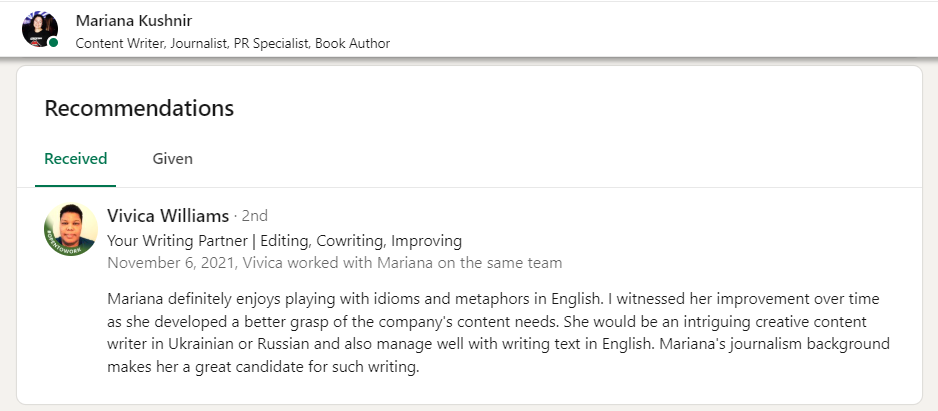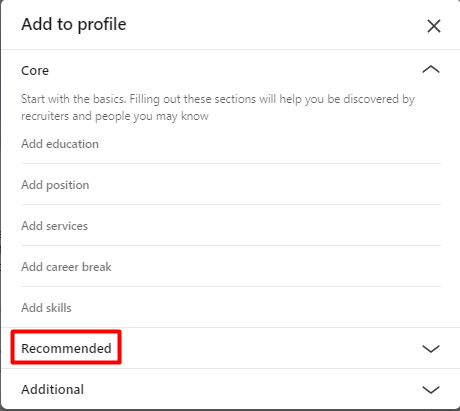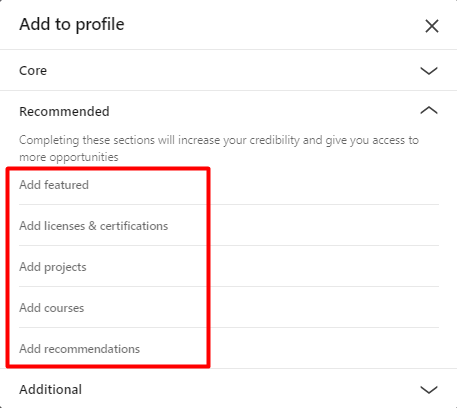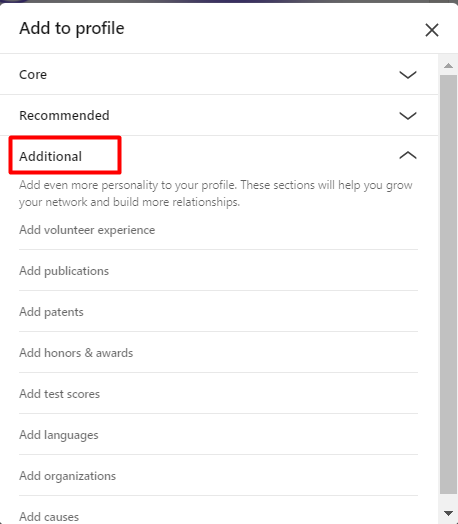In a world where we’re all trying to stand out, a good resume isn’t always enough to find a job you’ve dreamed about. You need an impeccable LinkedIn portfolio to catch your next big opportunity.
Yet, not only job seekers looking to impress recruiters should consider preparing a portfolio on this social networking platform. A LinkedIn portfolio should also be an absolute must-have for a salesperson aiming to dazzle potential clients.
Why? Read on to find the answer and learn how to add a portfolio to LinkedIn that would make you look like a rock star in your industry.
Outline
What is a LinkedIn portfolio?
A portfolio on LinkedIn is a section on your professional LinkedIn profile where you can showcase your shining projects, skills, awards, and achievements. That’s a sort of career highlight reel, just without that cheesy background music.
|
💡 Expert note What’s the difference between a LinkedIn portfolio and a resume? Unlike a resume, a LinkedIn portfolio goes beyond words to show recruiters or hiring managers what you bring to the table. For every job seeker, a portfolio on LinkedIn is a chance to wow potential employers with real-world examples of their work. |
Why LinkedIn portfolio matters for salespeople
Your profile is often the first impression you make on prospects. It’s your personal brand’s storefront, so every detail counts, especially your portfolio. A good portfolio on LinkedIn helps you demonstrate expertise, build trust, and astound prospects visiting your profile.
It is especially important in tech industries, where the products are complex and sometimes difficult to grasp. By displaying successful case studies, pitch decks, and product demos in your portfolio on LinkedIn, you’re proving you’re an expert in your field.
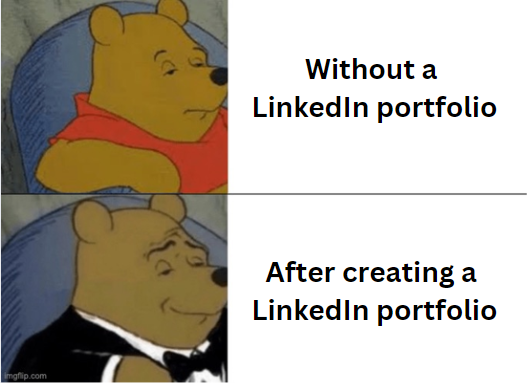
Simply put, your LinkedIn portfolio is like a calling card, showing prospects they’re about to partner with someone reliable.
|
🎁 Take a moment to review your profile Is your headline compelling? Does your photo have the right professional vibe? And what about your background image? Does it draw prospects in or unintentionally send them running? Every feature, from your summary to your visual elements, must align with your goals — attracting and engaging the right target audience. Check out this free guide that offers some actionable tips on how to level up your LinkedIn profile design. |
Even if you’ve polished your profile so it looks as sharp as a freshly minted hundred-dollar bill, it’s only the first step to success. Preparing a good LinkedIn portfolio that will draw public attention to your expertise and your product should go next.
What to show in a LinkedIn portfolio: best practices and tips
Now, it’s time to work on your outstanding LinkedIn portfolio. I’ve prepared a good deal of creative ideas on what to include in it:
1. Add a portfolio link
If you already have a personal website or an external portfolio, link it to your LinkedIn profile. This way, viewers can explore your work without limitations. Bonus points are if your site is sleek and easy to navigate — it’ll leave a good impression for sure.
For example, I added a link to my Snov.io blog page, which features all my published articles:
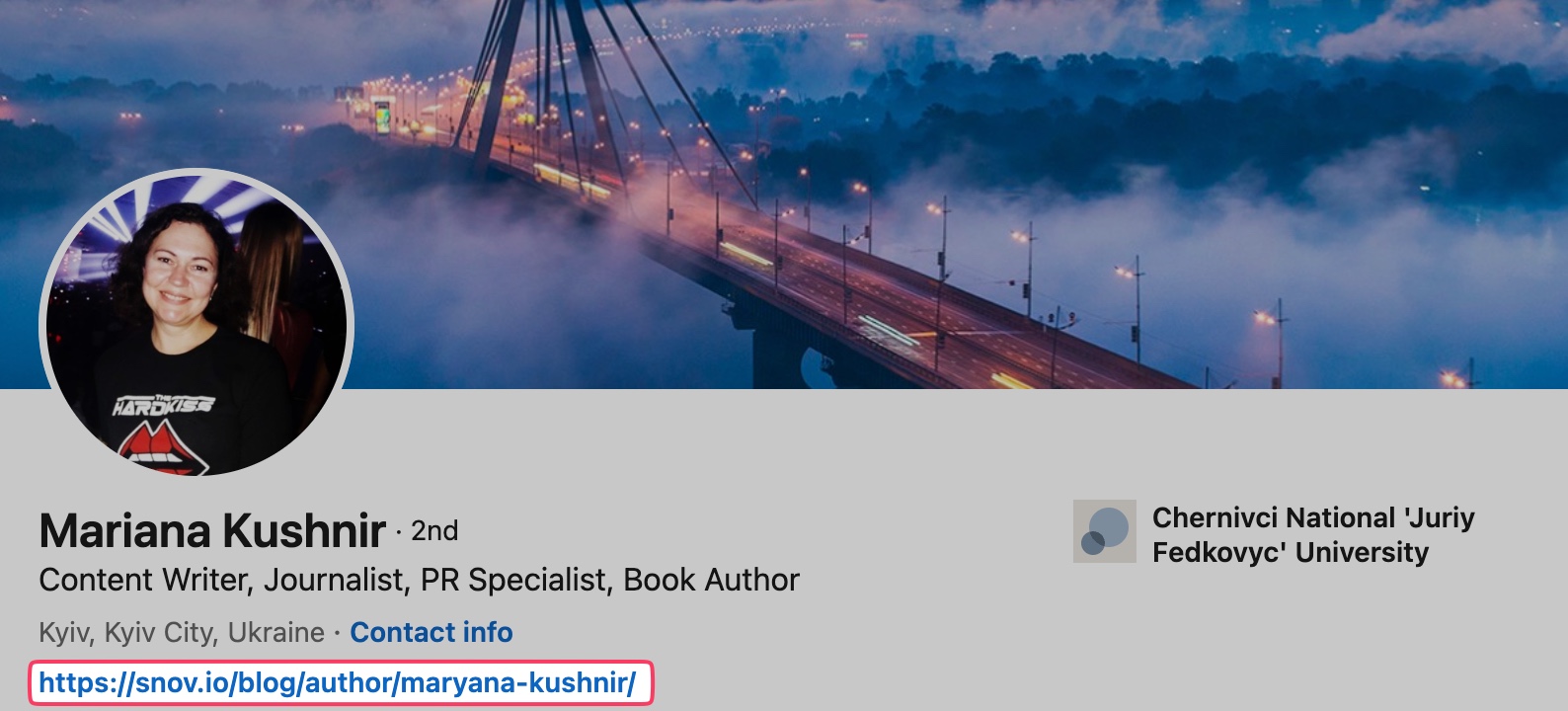
2. Use other links to promote your services
This strategy works really great for those who are offering coaching or consulting services. But not only. The link can lead users to a landing page that displays your product. Or else, you can direct potential prospects to a calendar where they may book a direct call with you. So, instead of browsing your profile, people will be encouraged to engage with you directly.
Just ensure you’ve created a compelling title or description for your URL that encourages users to click. Consider call-to-actions like “See my latest projects,” “Book a free consultation today,” or a cue from the following example:
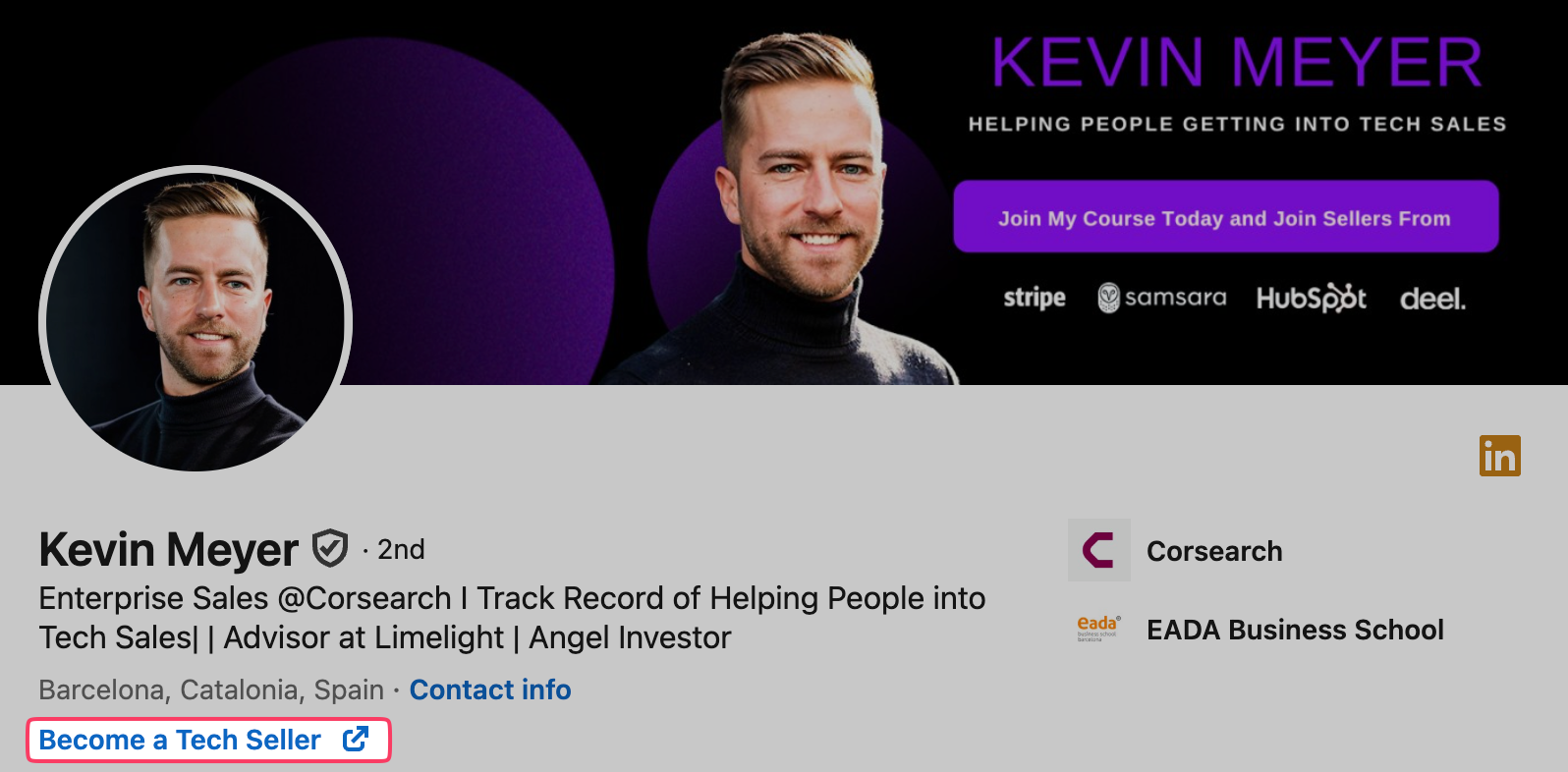
If you’re selling a tech product with multiple features, a good idea is to create a separate portfolio on LinkedIn dedicated solely to it.
For example, at Snov.io, we’ve got a portfolio that helps our prospects learn all the peculiarities of our versatile SaaS tools:
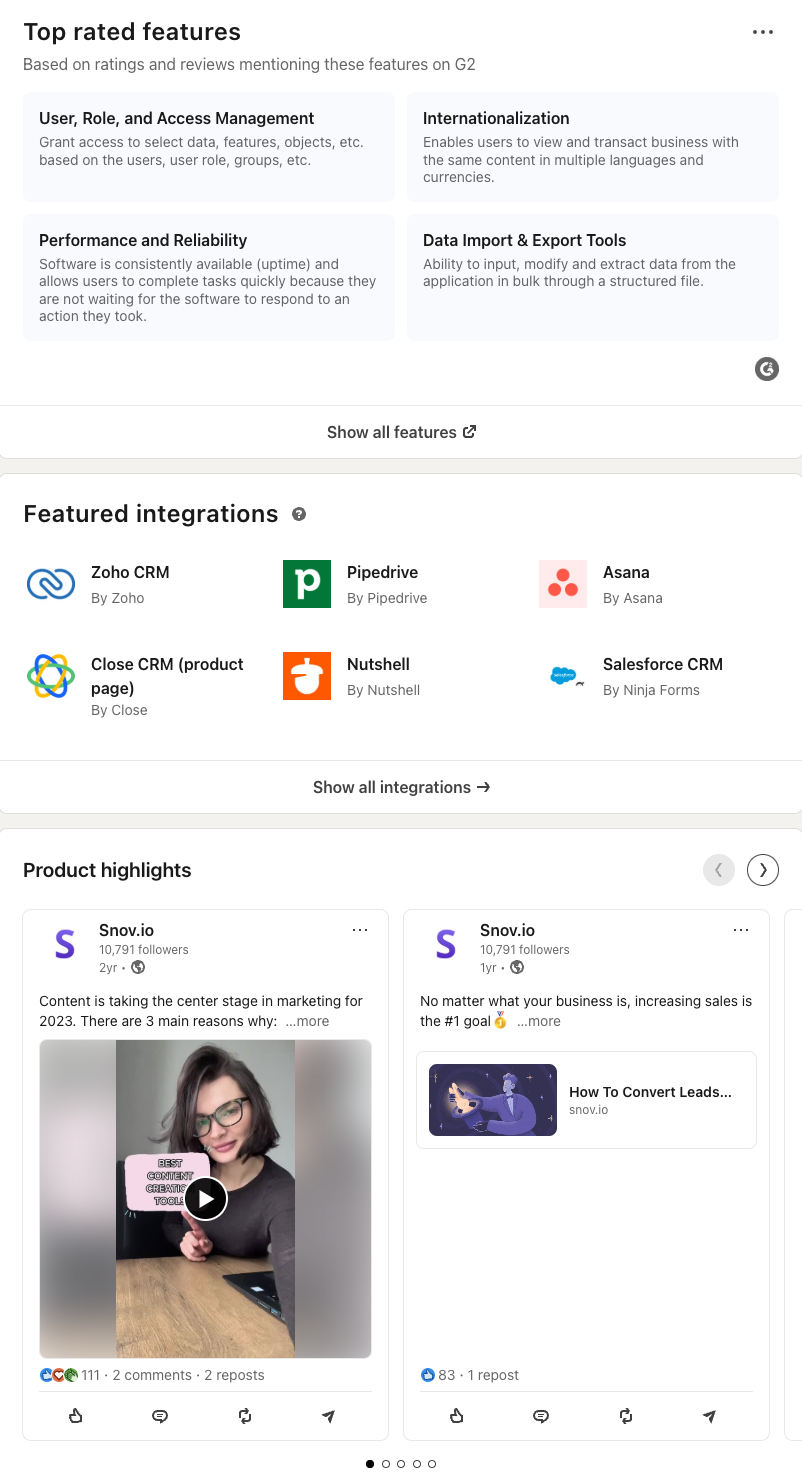
|
💡 Expert note Elaborating on a portfolio is a key step for inbound lead generation on LinkedIn. As soon as you’re ready with your profile, you’ll be ready to go outbound and start networking and collecting leads proactively. With the LinkedIn automation solution from Snov.io, for example, you’ll be able to set up the following automated steps of your strategy:
|
3. Display reviews as testimonials
Ask clients to share their experiences with your products or services and display them proudly on your LinkedIn portfolio. Nothing beats a glowing review.
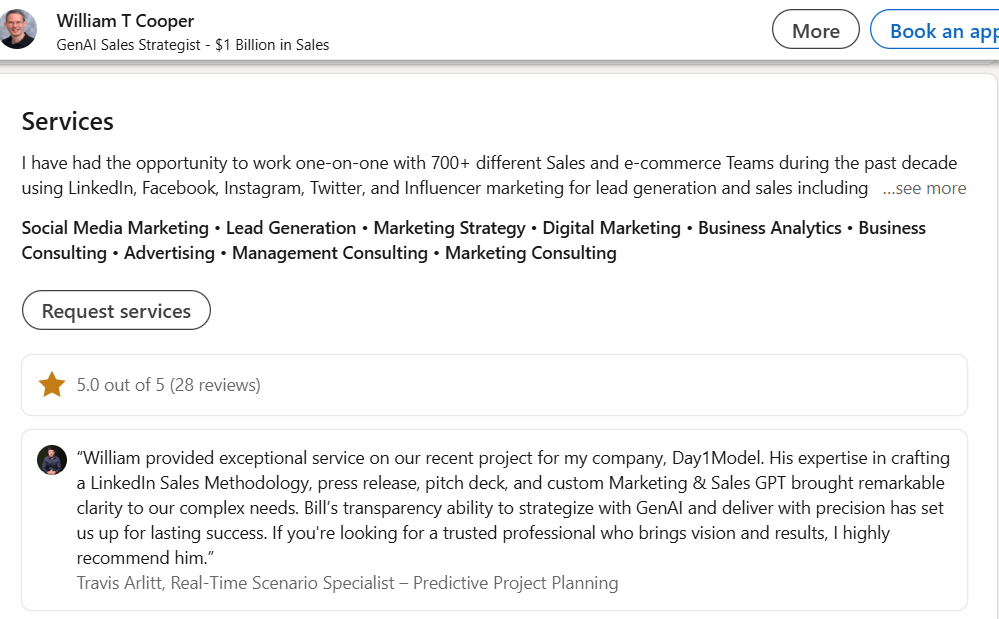
→ Want to streamline your LinkedIn outreach? Check out our compilation of the best LinkedIn automation software to choose from!
4. Show your projects
Highlight projects that reflect your expertise by including various work samples. These could include publishing a book, designing a website, launching a successful marketing campaign, or implementing a complex tech solution. I highly recommend you include a short description of every project to provide context and explain your role:
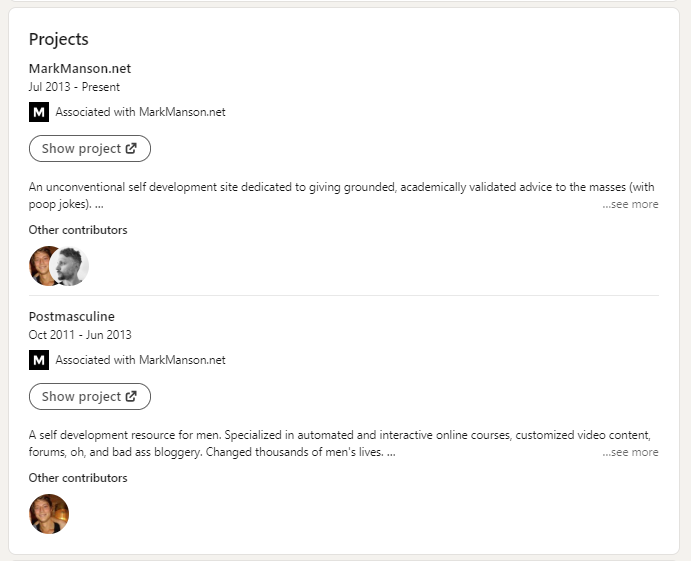
5. Provide case studies
Got a client describing their positive experience with your product or service on their page? Display it on your LinkedIn portfolio. Let people see the detailed breakdowns of your most impactful solutions. Just ensure the case studies describe the problem, how you helped to solve it, and the positive results.
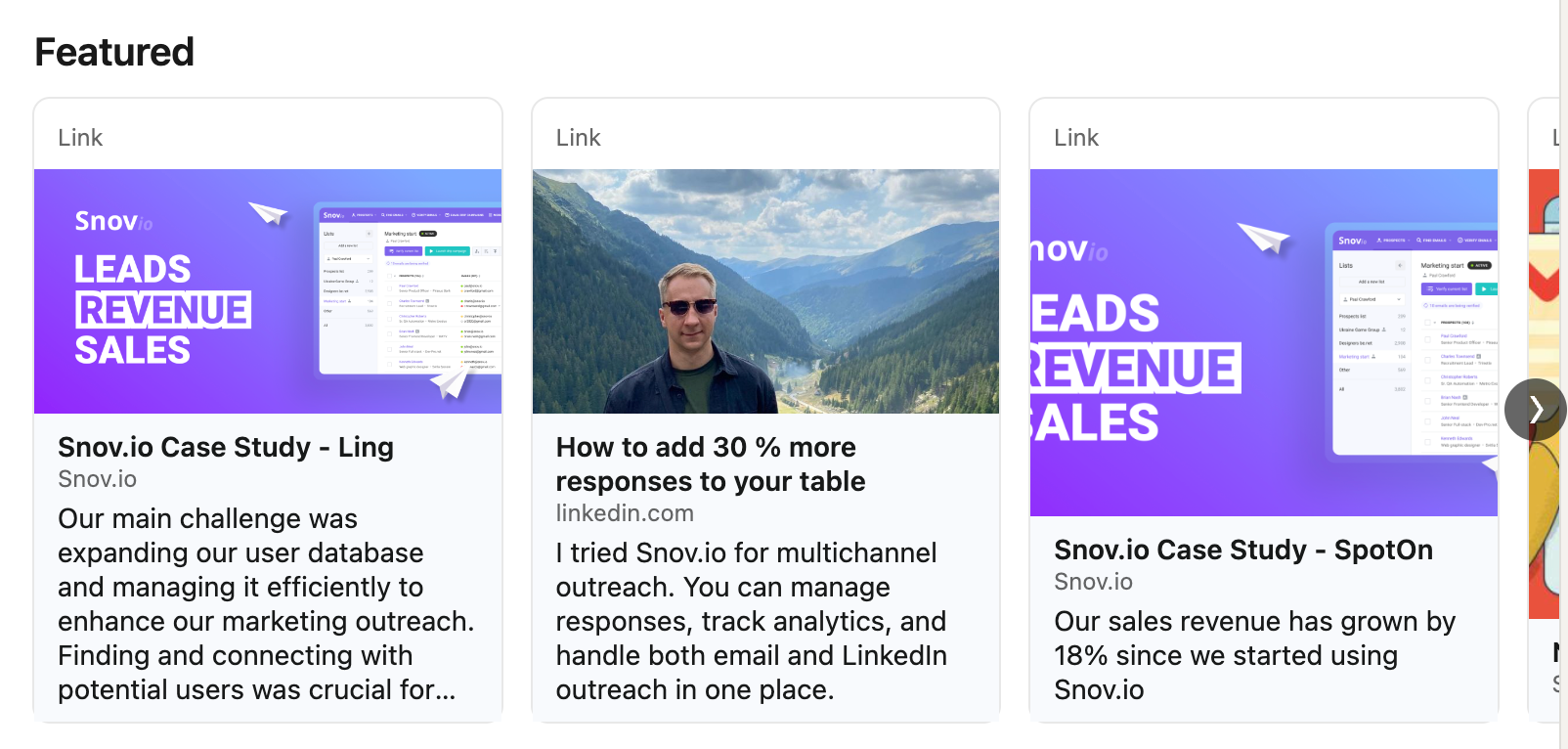
6. Add media
Share images, videos, and even slideshows to give viewers a peek into your work. A dynamic presentation or a video explaining your achievements can leave a more substantial impact than a paragraph of text. Just follow a good example of our marketer, Ksenia, whose portfolio features her most recent educational videos:
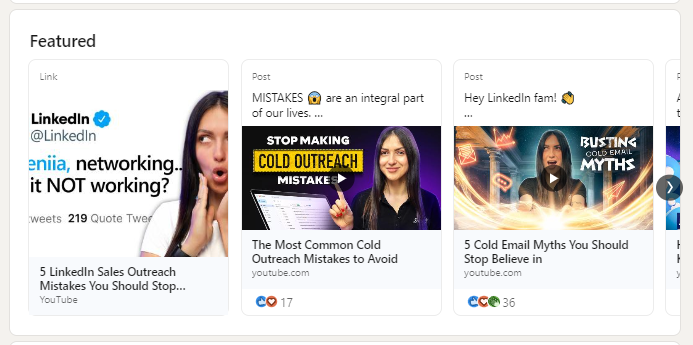
If you want to add a bit of a futuristic touch to your LinkedIn portfolio, then embed infographics, interactive visuals, or AR/VR content.
|
💡 Expert note Visuals help convey complex information more effectively, leading to better audience comprehension. Recent studies support the importance of incorporating visuals, particularly videos, into your LinkedIn portfolio:
|
7. Add licenses and certifications
Mentioning them in your portfolio on LinkedIn serves as solid evidence of your skills, setting you apart from other experts. A good sign is when your certifications highlight your industry-specific credentials. So, if you’re a seasoned and results-driven digital marketer like our Victoria, don’t be shy to add the relative certifications:
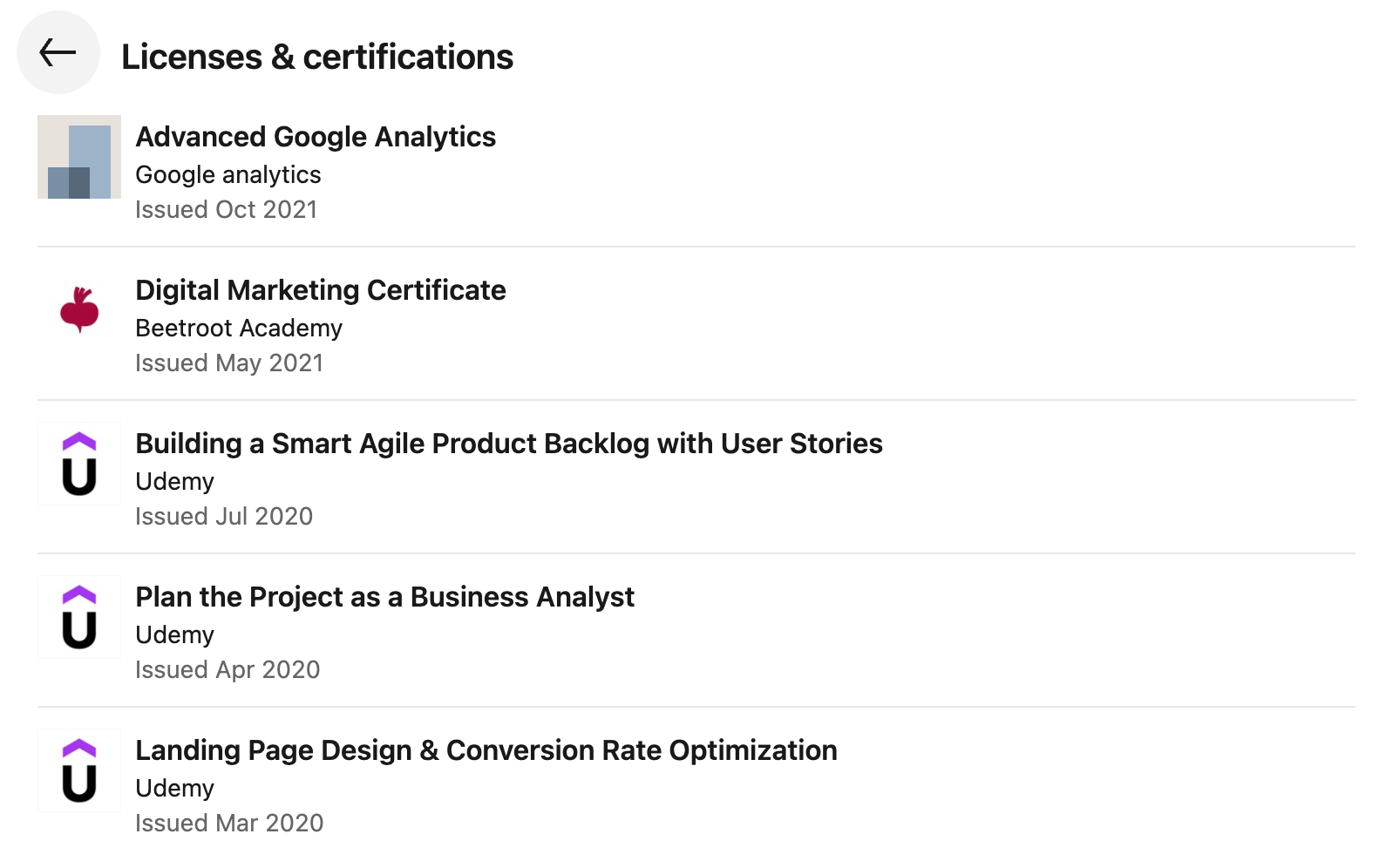
8. Share your publications
Have you ever expressed your expert opinion in blogs, online magazines, or other publications? Let the LinkedIn audience know about it. This will only strengthen your professional image and prove your credibility and expertise.
Snov.io’s email marketing specialist, Inna, for instance, is often featured in other publications. Not displaying these contributions on her LinkedIn profile would be a crime:
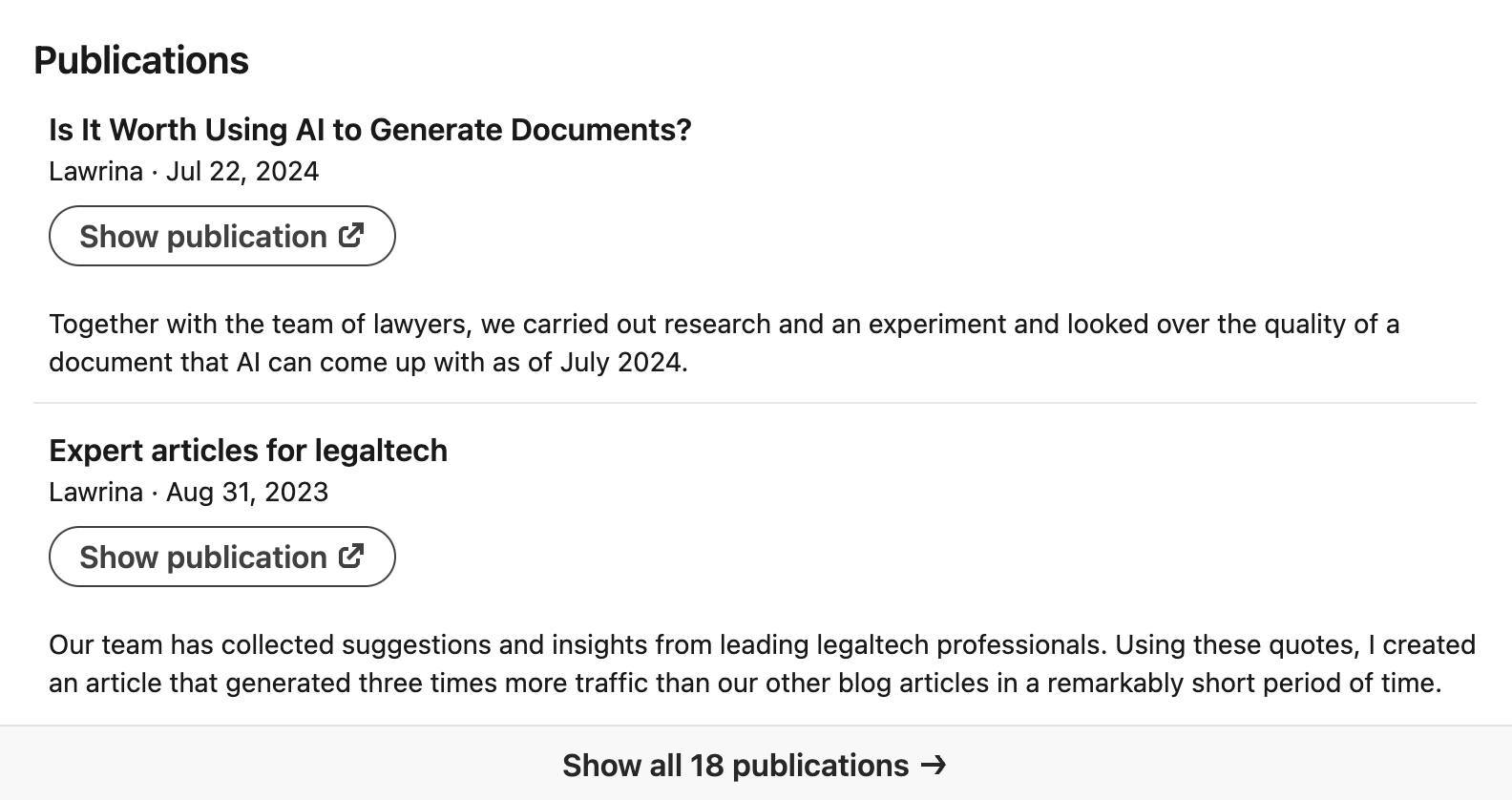
9. Add honors and awards
When you add honors and awards to your LinkedIn portfolio, it means others have recognized your talent, dedication, and hard work. This section immediately communicates your trustworthiness and distinguishes you from the competitors.
Just a couple of ideas on how to make the most of this LinkedIn portfolio section:
- Show your achievements
Add awards that are relevant to your career or industry. It would be silly not to boast your “Top Performer of the Year” award or an industry-specific honor. For sure, it adds value to your professional story.
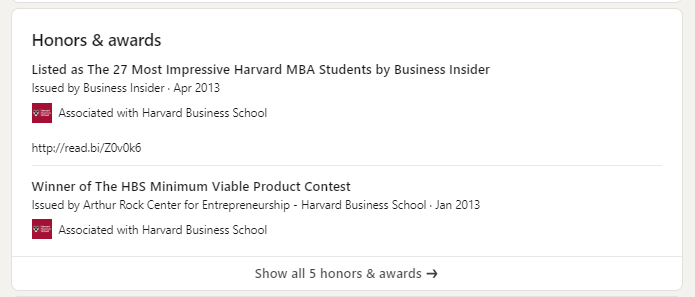
- Include context
Don’t just list the award — explain what it means. For example, if you were named “Best Innovator” at your company, mention the specific project or initiative that earned you the recognition.
If your award was part of a competition (e.g., hackathons, pitch contests, sales or marketing challenges), note the scale and competitiveness of the event. It will make your accomplishment even more impressive.
10. Share recommendations
This part of a portfolio can be particularly valuable for career growth on LinkedIn and beyond. You can ask your current or ex-employer or colleagues to drop some lines about your achievements. These positive characteristics will add you points in the eyes of recruiters when you’re looking for a job:
11. Create and post engaging content
Your portfolio doesn’t have to be static. Share your expertise and insights which might be of interest to your audience. Post articles, updates, and original content to demonstrate your thought leadership. Who knows? Your next post might go viral and land you a job…or a client.
Moreover, remember that everything you post is carefully saved in your LinkedIn account, making your professional voice ‘sound loud’ permanently. Our Head of customer operations, Roberta, often engages the audience with sincere stories from her professional experience. And, of course, she doesn’t forget to share some catchy memes from time to time:
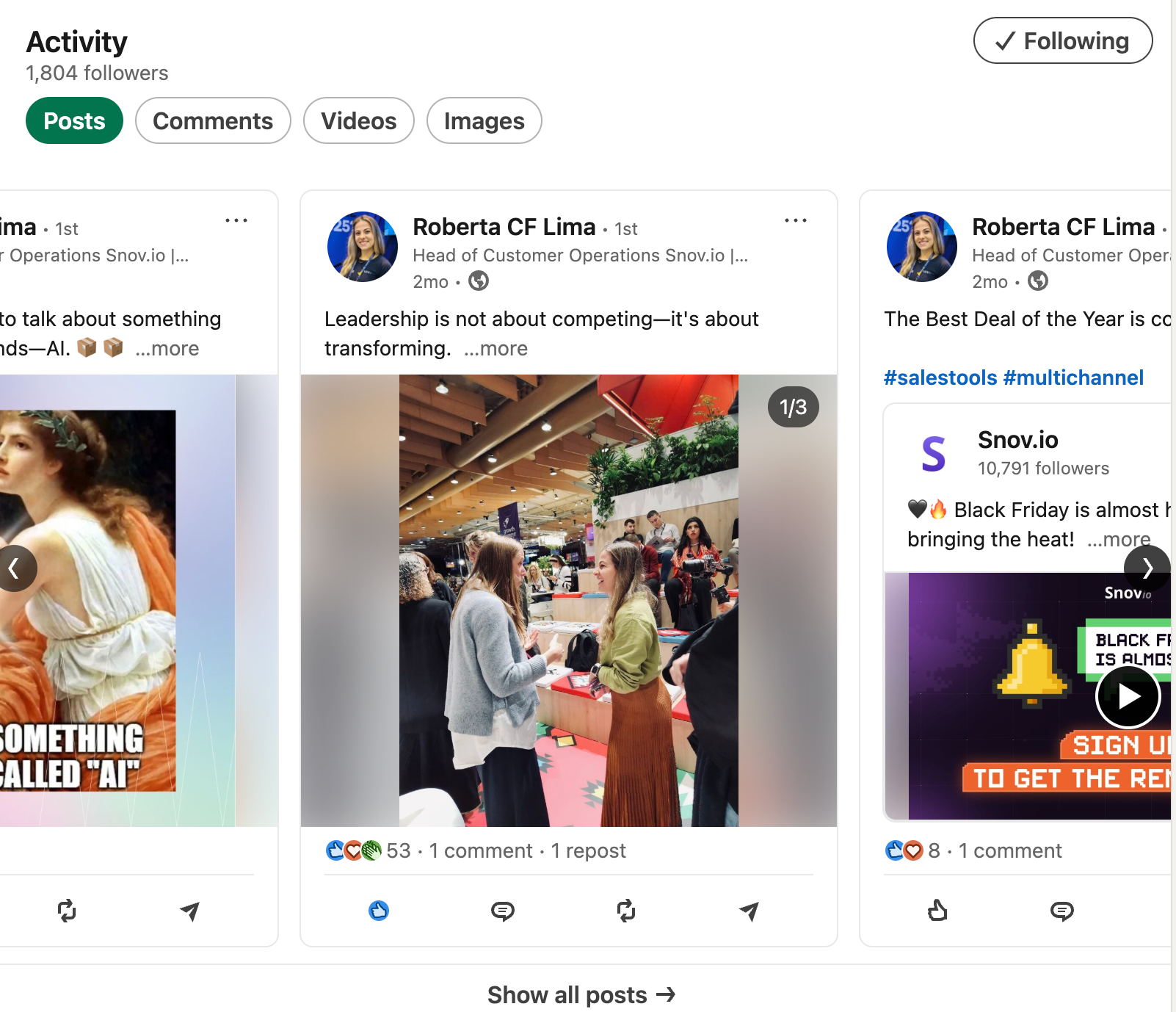
12. Mention volunteering projects
Though not an obligatory section, it can tell a story that’s uniquely yours. It shows you’re not just a competent professional but also your other side as an engaged, interesting personality, capable of thinking outside the box.
Demonstrate volunteering activities, hobbies, or projects that tell more about your personality. Just like Snov.io’s partner manager Nathalia did on her portfolio:

In addition to the above elements of your LinkedIn portfolio, you can add:
- your courses,
- test scores,
- patents,
- organizations where you’ve got membership,
- causes that matter to you most, etc.
All these sections will make your profile more appealing to potential connections. And if you’re pursuing your sales goals, they’ll serve you as a smart strategy for generating quality leads.
How to add a portfolio to LinkedIn in just a few simple steps
Now that you know what is best to include in your LinkedIn portfolio, let’s get technical. Adding a portfolio to LinkedIn isn’t higher mathematics. It’s simple, like peanuts:
1. Go to your profile, find and click ‘Add profile section’:
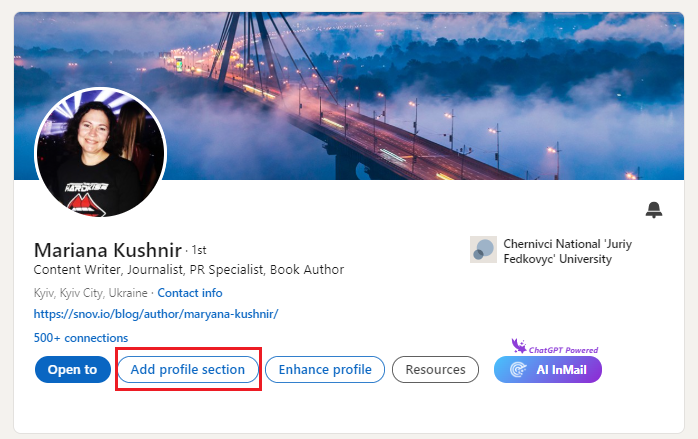
2. Choose a ‘Recommended’ section:
As the list unfolds, you can start filling in the relevant data about your projects, certifications, courses, or recommendations.
3. Select ‘Add featured’ if you’re showcasing posts, newsletters, articles, media, or providing links to your portfolio, product landing pages, etc.
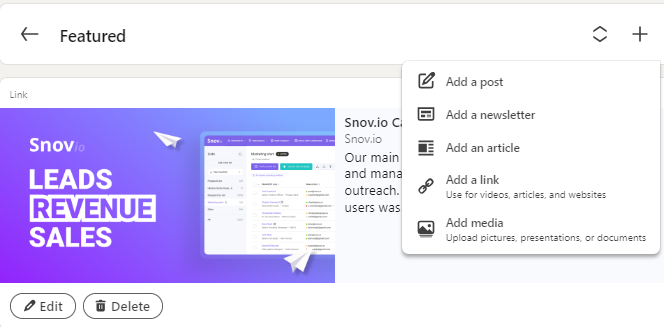
4. Click on the ‘Additional’ section to add details about your volunteering experience, publications, patents, honors and awards, test scores, languages, organizations in which you’re a member, or causes you care about.
|
💡 Pro-tip: Add context Write a catchy title and a brief description for each section of your LinkedIn profile. This will help viewers understand what they’re looking at and why it matters. |
5. Hit save, and you’re done!
LinkedIn portfolio examples for your inspiration
Now, let’s look through several examples of LinkedIn profiles, finding and discussing the elements that make them outstanding.
A Growth Marketer from CookUnity
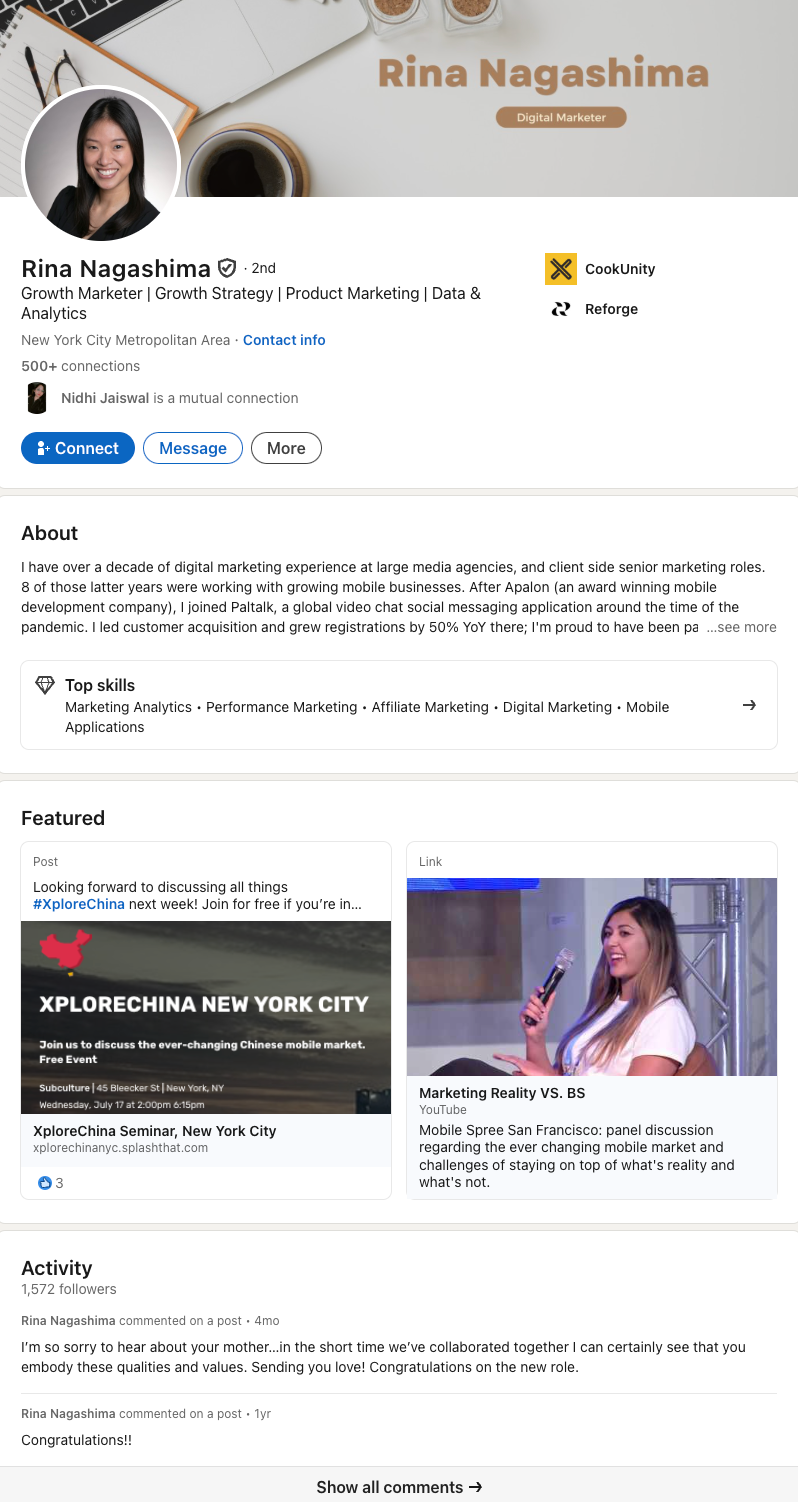
What is good about Rina’s LinkedIn portfolio:
Rina posts events that she participates in to demonstrate her expertise and focus on growing her skills. The portfolio also features certifications in email marketing and product management, which prove that the owner of this profile has gained the necessary knowledge and skills in her industry.
In addition, Rina highlights her volunteering work, highlighting her status as a professional and philanthropist.
A Sales Manager from Quartile
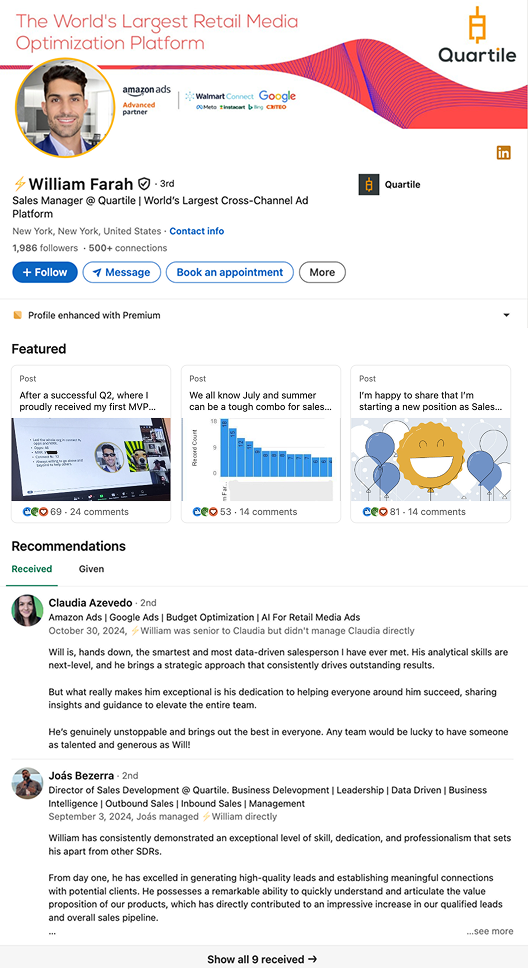
What is good about William’s LinkedIn portfolio:
William regularly shares his successful career milestones, sales presentations, and valuable insights that prove his strong qualifications and experience. The portfolio also includes stellar reviews of his sales skills from happy clients and colleagues. Lots of recommendations feature his proficiency in closing deals and solving customer challenges.
The sales manager also shares his experience with getting a scholarship and membership in AISAS, which makes his persona more respectable.
A SEO Expert at Search Intelligence Ltd
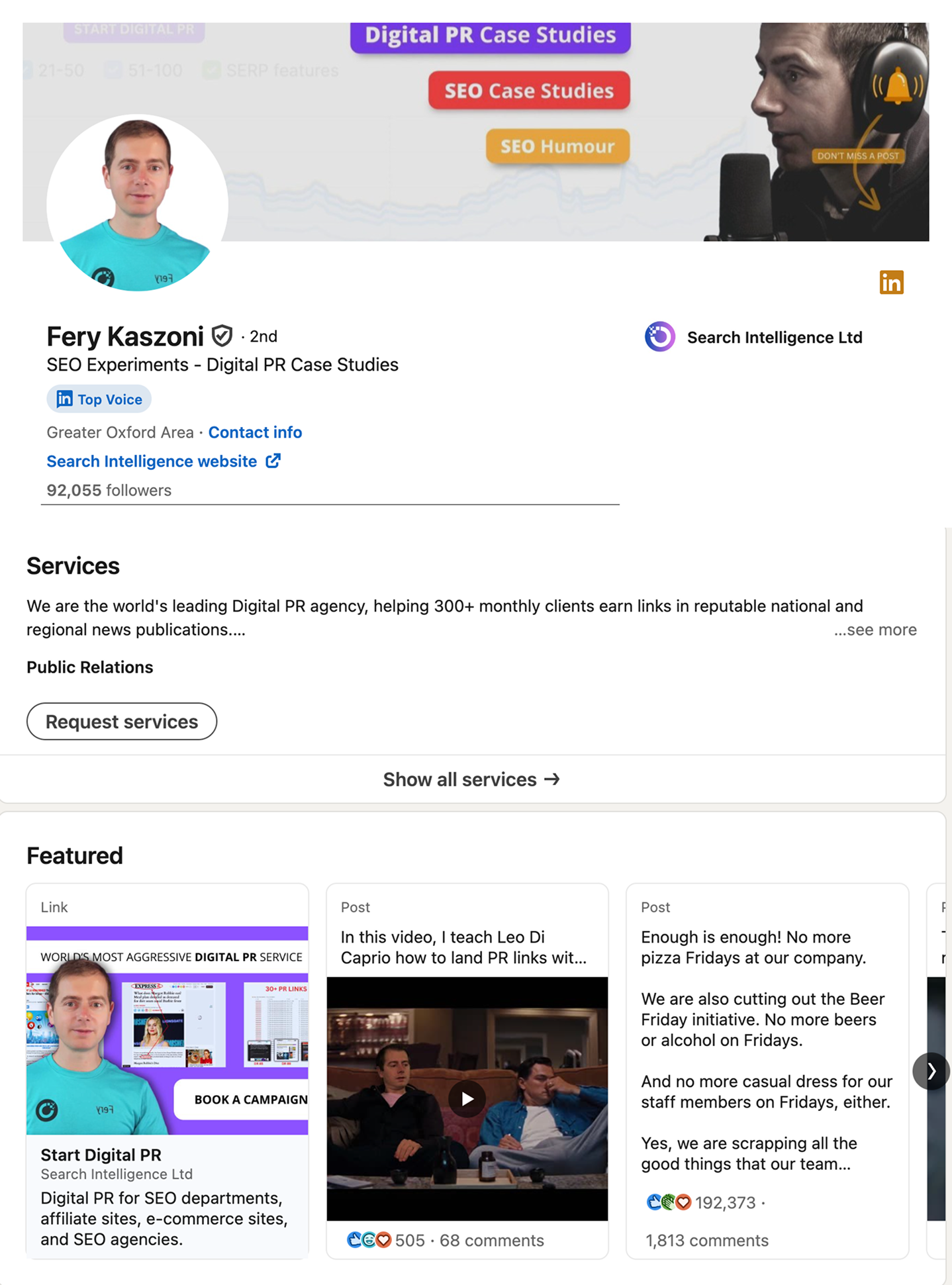
What is good about Fery’s LinkedIn portfolio:
It features a Top Voice badge, which indicates that this expert belongs to the invitation-only group of experts across the professional world.
The main focus of this portfolio is on displaying the services this expert’s company provides. In the corresponding section, the expert shares a detailed description of what their company offers and their value proposition. The expert underpins it by providing a link to the company’s website and featuring company-related content.
But what makes this profile really outstanding is the AI-generated video posts that combine humor and professional hacks. The one where the expert teaches Leonardo Di Caprio how to land PR links is pure gold. There’s no surprise it has got so many reactions:
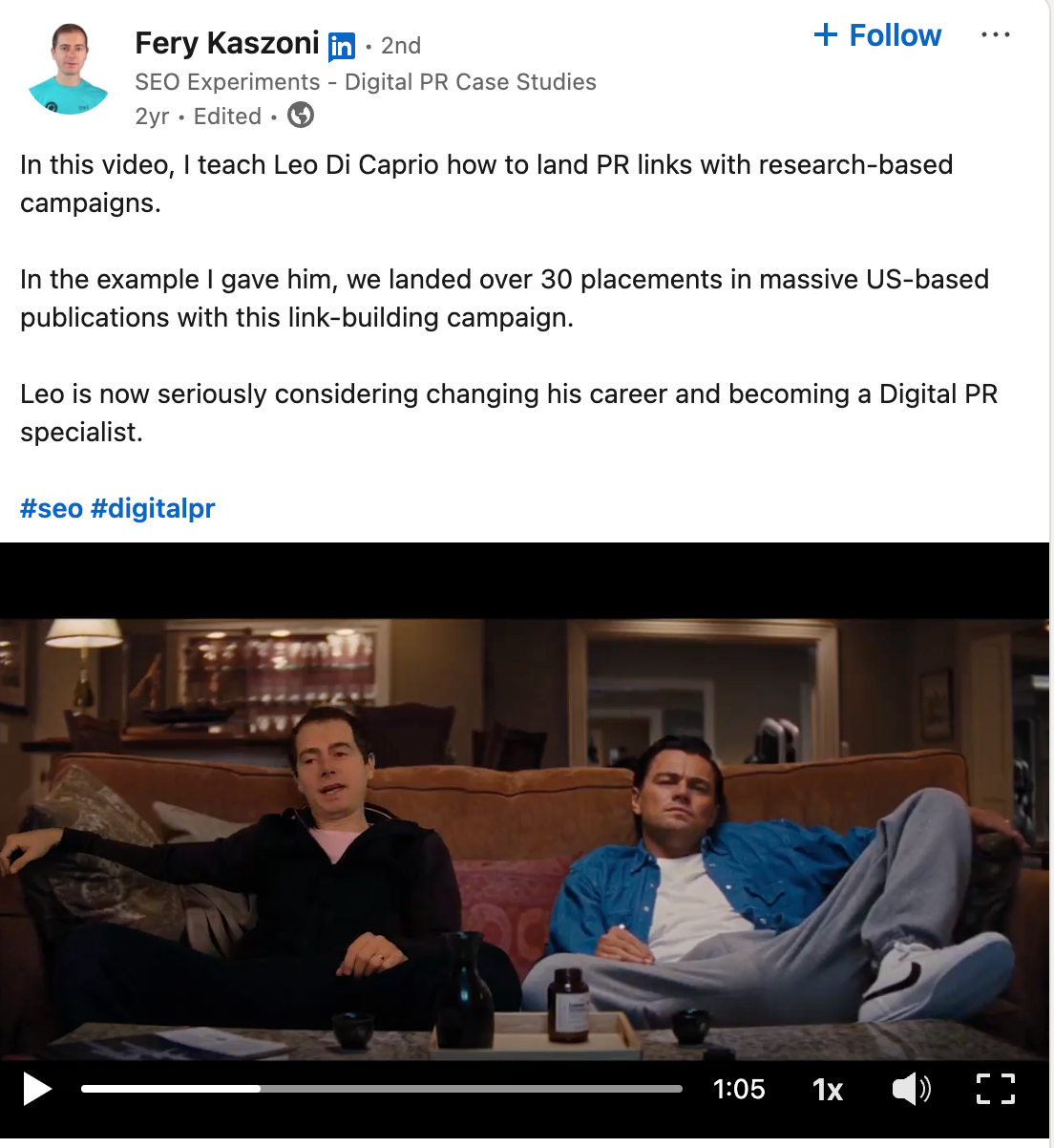
What’s next
I hope the above tips and examples will help you create your LinkedIn portfolio with ease. Remember, you’ve got plenty of sections to fill in, so let your profile shine among the rest!
And as you’re ready with your portfolio, don’t stop. Start growing your network of connections proactively. On our blog, you’ll find plenty of guides that will help you expand your audience and generate leads on LinkedIn. Meanwhile, Snov.io tools will automate the process for you from A to Z.
We’re always here to help your business grow!

